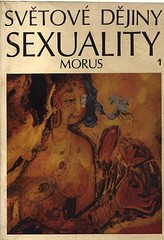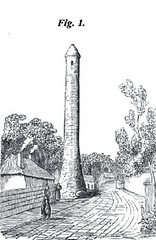Introducing Richard Lewinsohn (1894 – 1968)
Translation of A History of Sexual Customs (1956) by Richard Lewinsohn
Flipping through my Dutch language copy of the above book brought German writer Richard Lewinsohn to my attention who published this book under the pseudonym Morus. I read a bit in the chapter on sexuality in ancient Rome and found a reference to Tutunus, the Roman equivalent to Priapus of Greek mythology. Tutunus is very badly represented online, but that’s how I found out that Morus is a pseudonym for Lewinsohn.
Tutunus is expounded upon in Aphrodisiacs and Antiaphrodisiacs , a book by English author John Davenport privately printed in London in 1869 from which the following illustration comes:
Round tower at Clondalkin (Aphrodisiacs and Antiaphrodisiacs proves that the notion op phallic symbol to connote non-sexual imagery existed before Freud)
Richard Lewinsohn (September 23 1894 in Graudenz; – April 9 1968 in Madrid) was a German writer, journalist and cultural historian. He wrote several works under the pseudonym Morus and Campanella. He was a contributor to Die Weltbühne and is known for such works as A History of Sexual Customs (1956) and his biography of arms trader Basil Zaharoff.
Also a German jew, contemporary of my hero Walter Benjamin, Lewinsohn managed to survive the war. His work is largely undocumented in the Anglosphere.



Thank’s for the pointer. I just ordered my copy!
You’re most welcome, I think you will like him, the amount of research that went into this book is stupendous, and the sweeping generalizations seem to be on the mark. Let me know what you think of it.
Jan
Yes, I am very curious to see the research he did and how he drew his conclusions. Seems like a difficult topic to get hard evidence about.
I’m skipping randomly through this book, and it is very interesting and entertaining. He has a fluid style, at least in translation. I thought his discussion of Greek attitudes was very good, and I found myself fascinated, I don’t know why, by his descriptions of Napoleon’s sex life. It certainly adds something to one’s understanding of the ‘great’ man.
At first, I was disappointed, having hoped for a detailed discussion of sexual practices. How ever would he have documented that, I wondered, and of course, there is little. On the other hand, as he remarks of the Kama Sutra, there is little in it that young people haven’t discovered on their own without the benefit of reading it. Likely, what people do with one another while having sex is probably the same everywhere, at all times. How they think of it, when they do it, and with whom is what changes.
I thought his discussion of Greek attitudes was very good,
Yes! It struck me as someone who has absorbed (as opposed to recently learned) a great deal of antiquity.
Napoleon’s sex life
One of my favourite chapters!
Does your copy have an index?
Have you read the similarly themed Obscene: The history of an indignation (1962) by Ludwig Marcuse? I read that one from cover to cover.
Does your copy have an index?
Yes, a pretty nice one. I appreciate a good index, especially in books written before computers were used!
Don’t know the Marcuse book. No relation to Herbert, is there?
No, no relation, just an old wise man reporting on leading obscenity trials: Friedrich Schlegel’s Lucinde (Jena, 1799), Gustave Flaubert’s Madame Bovary (Paris, 1857), Arthur Schnitzler’s Round Dance (Berlin, 1920), D. H. Lawrence’s Lady Chatterley’s Lover (London, 1960), and Henry Miller’s Tropic of Cancer (Los Angeles, 1962). A chapter is also devoted to the crusade of Anthony Comstock and the New York Society for the Suppression of Vice.
There’s a fair amount about Comstock and friends in this book too: Visual Shock: A History of Art Controversies in American Culture by Michael Kammen. It was pretty interesting.
… Napoleon’s sex life
… One of my favourite chapters!
From an obituary in the NYTimes – a local boy:
… although there is some dispute about its authenticity, Dr. Lattimer also had in his collection what is said to be Napoleon’s penis, which a long tradition holds was removed by the priest who administered the last rites.
http://www.nytimes.com/2007/05/13/nyregion/13lattimer.html